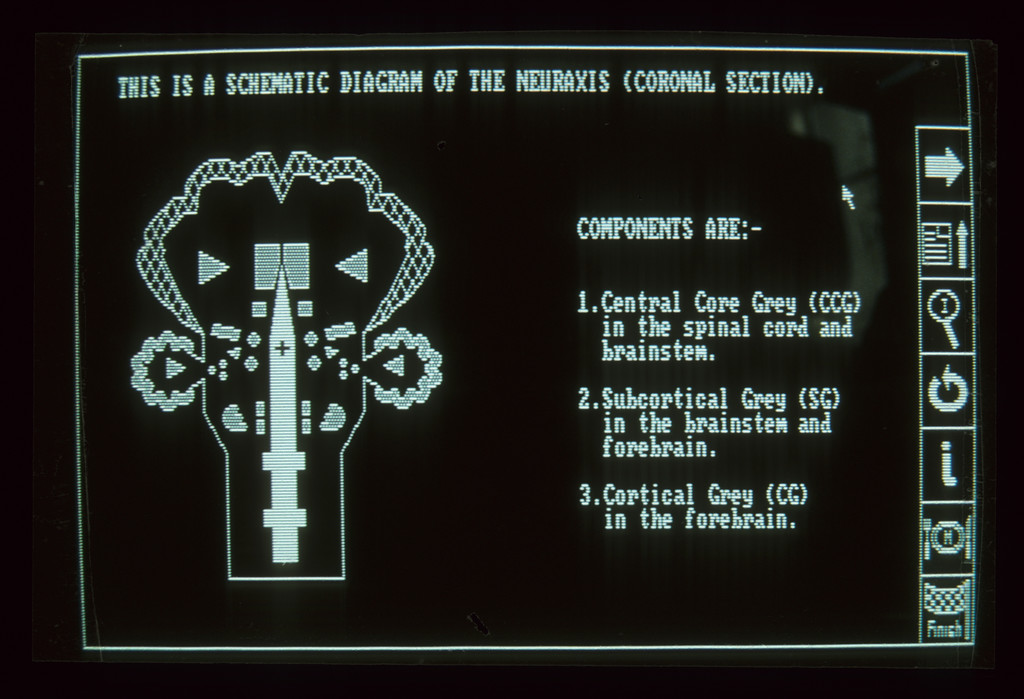The “Magic Browser” derives from two things: “Browser” and “The Magic Browser Tool”.
“Browser” derives from the first concept demonstrator, “The HNS Browser”, 1986.

This is a screenshot from “The HNS Browser”, 1986 – created on a Compaq Portable PC coded in a version of Basic. It was a “concept demonstrator”. The concepts and ideas included: (i) a simple graphical schema of the human nervous system derived from an analysis of the system – as a map/blueprint composed of the fewest key elements representing/capturing the essence of a system or domain – in this case the human nervous system – as simple graphical symbols, each one a “category” – effectively encapsulating detail; (ii) “browsers” as graphical interfaces (GUIs) for parsing, browsing and the selection of elements of interest (here, with a mouse cursor) for discovery; (iii) “active and interactive” – active element-by-element composition of the schema on the display screen, and interactive display where an element can be displayed by selection of a label from a list and/or where an label can be displayed by selection of a graphical element (symbol). Notice the simple menu design – of the fewest Buttons.

This is a screenshot from “The HNS Browser” – where the “user” has selected the “Interrogate Button” (magnifying glass) which has revealed all the selectable/interrogatable elements and turned the simple mouse pointer into a magnifying glass which can be employed to locate selectable elements of interest: here, both Words/Labels and Symbols/Graphical Elements. [This in fact illustrated Paivio’s Dual Coding Theory]. Here, for example, “Coronal” is the type of anatomical section of the Neuraxis (Brain and Spinal Cord) and “CCG” is the “Central Core Grey” (a category I defined of the Grey Matter (Neurons) of the Neuraxis. This display being interactive where an element can be displayed by selection of a label from a list and/or where an label can be displayed by selection of a graphical element (symbol).
See: The Information Modelling Programme” Evolutionary Series of Prototypes
The “Magic Browser”
The ”Magic Browser” was a very small object-oriented HTML multimedia document authoring and display tool for Microsoft Windows. The magicbrowser.exe file was around 289 Megabytes in size – leaving over 1 MB remaining for the storage of a multimedia document on a Floppy Disk.
“Browsing” was the key interaction – think – interest – create – share – browse – interest – select – discover!



“The GPE” – “The Media Language” – “Paris” HTML Browser – “The Magic Browser” – “GARDEN” – “IMPFW”
A number of information modelling tools and demonstrator applications were designed and implemented between 1986-1997. They all presented as “browsers”.

This is a screenshot from the “GPE Tool” – reproducing the HNS Browser and more.

This is a screen shot from the “Media Language – STILE Browser”

This is a screen shot from “The CLCV Browser” constructed with the “Magic Browser Tool”.

This is a screenshot from the “EFC Browser” built with the “GARDEN Prototype Tool”.

This is a screenshot from the “IMFW Prototype Tool”.
The “Magic Browser Website” was named after these browsing prototypes
See: The Information Modelling Programme” Evolutionary Series of Prototypes
